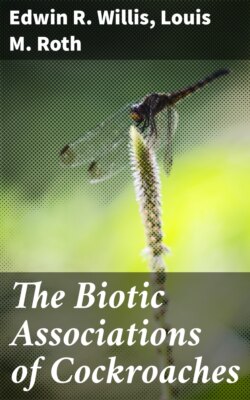Читать книгу The Biotic Associations of Cockroaches - Edwin R. Willis - Страница 169
На сайте Литреса книга снята с продажи.
Cariblatta lutea lutea
ОглавлениеNorth Carolina.—Under pine straw on ground in woods (Brimley, 1908).
Southeastern U.S.—Under dead oak leaves; under dead needles in longleaf-pine woods; in wire grass; under refuse; beaten from undergrowth in pine and oak woods (Rehn and Hebard, 1916). In undergrowth of shortleaf-pine, longleaf-pine, and oak woods; in heavy scrub in damp spot of sand dune area; from high bushes, Ilex coriacea [= lucida] along inland swampy area (Hebard, 1916a). "The species is in large part terrestrial, being usually found among dead leaves and litter on the ground. Occasional specimens are, however, sometimes beaten from bushes. Individuals are decidedly active and are usually to be found in the greatest numbers in sandy situations" (Hebard, 1917).
Florida.—Throughout winter and spring they are frequent beneath leaves and other debris on ground, especially in dry, sandy locations (Blatchley, 1920). Friauf (1953) found this species under debris, fallen leaves, leaf mold, or decaying wood in these habitats: Dry, ruderal grassland (infrequent), scrub (frequent), sandhills (dominant), xeric hammock (infrequent), mesic hammock (dominant), pond margin (infrequent), longleaf-pine flatwoods (frequent), bayhead (occasional), low hammock (frequent), and alluvial hammock (occasional). In the shrub stratum in these habitats: Scrub (frequent), sandhills (dominant), and xeric hammock (infrequent). In herbaceous stratum in these habitats: Sandhills (dominant), mesic hammock (dominant), and black-pine flatwoods (infrequent). On bare soil or bare sand under vegetation in these habitats: Sandhills (dominant), pond margin (infrequent), longleaf-pine flatwoods (frequent), and slash-pine flatwoods (frequent) (Friauf, 1953).
